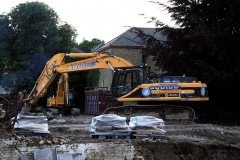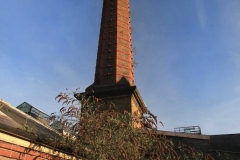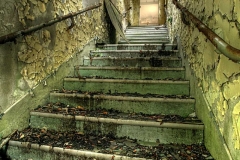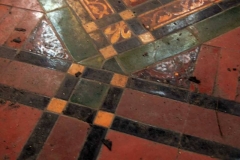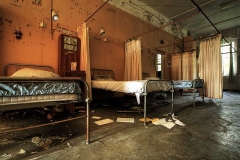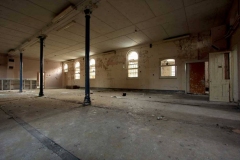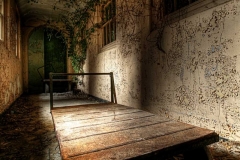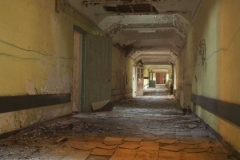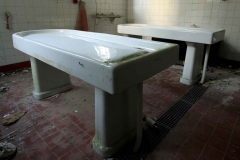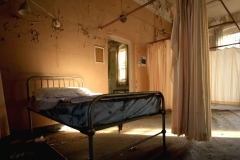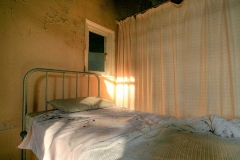The Evolution Of Mental Hospitals In Britain
This article is a valuable resource detailing the entire history of the lunatic asylum. We are so fortunate to bring this to you, and it is especially poignant, as it comes to you just as Cane Hill is being demolished. Also shown are images of Cane Hill in an advanced state of dereliction. We are indebted to Alexander Walk, late Superintendant of Cane Hill, Coulsdon, for his legacy.
Alexander Walk, M.D., D.P.M.,
late Physician Superintendent, Cane Hill Hospital, Coulsden.
These papers were read at the Third British Congress on the History of Medicine and Pharmacy on 26th-28th September 1962.
Mental Hospitals
ALEXANDER WALK
THE ROYAL HOSPITALS, the voluntary hospitals which originated from the humanitarian movements of the eighteenth and nineteenth centuries, and the county and municipal hospitals which developed under the Poor Law, have all claimed your attention. The mental hospitals, with which I have to deal, belong historically to all three of these groups, and on this score alone would merit a fuller treatment ; but one has to remember also how closely their existence has been bound up with the social and legal implications of mental ill-health, what diverse ideas have been and are held about their purpose and function, and how the whole subject is beset by legend, prejudice and misunderstanding. The task of condensation is truly daunting, and I can only offer an outline of trends and events which may perhaps serve for better orientation in this field. While doing this I hope to bring to your notice some of the less familiar aspects of the subject, and perhaps to correct some current misconceptions. May I say here that we owe a great deal to the scholarly work in this field in recent years of Drs. Kathleen Jones, Richard Hunter and Denis Leigh. They will forgive me if now and again I differ from their conclusions.
We are often asked to believe that medical psychology in the seventeenth century was dominated by false ideas concerning witchcraft and demoniacal possession. Nevertheless throughout the century many people all over the country were applying confidently and successfully to the county justices for some assistance to their frenzied, melancholy or distraught relatives, without any question of witchcraft arising from their applications. 1 These applications were dealt with for the most part by way of “community care”—such as a grant of money to enable the applicant to “hire an able person to stay and look to” the patient ; or by lodging the patient with some person willing to keep him ; in a minority of turbulent cases the justices would order admission to a workhouse or house of correction, or occasionally to the one existing hospital, the Royal Hospital of Bethlem. In the next century, with the opening of other public hospitals and privately owned lunatic houses, these were used in addition.
Much has been made in some works of the terms of an Act of 1744, dealing with vagrancy and including a clause authorizing the justices to place a dangerous patient under control. Dr. Hunter and Mr. Payne have shown, however, that the clause was re-enacted from a previous Act of 1714, and as this latter was a consolidating Act, we may suppose that it merely recorded what had been the practice for many years previously. 2 The really significant feature of the 1744 version is that where the previous Act had referred to “removing, keeping and maintaining” the patient, on this occasion the word “curing” was added. Although far from mindful of their implied responsibilities, the Overseers did from time to time call in an experienced physician to advise on the treatment of their patients, at home or in the workhouse, as in the case recorded by Perfect in his Annals of Insanity. 3
The removal of Bethlem in 1676 to its new site (facing what is now Finsbury Circus and backing onto London Wall), the erection of what was considered the finest public building in London, and the appointment of Edward Tyson as its physician, all showed a growing confidence in the benefits that medicine might have to offer in mental illness. Nor were mental patients entirely excluded from the general hospitals. When Thomas Guy founded his hospital in 1722 he directed that it should include twenty beds for lunatics, priority being given to those discharged from Bethlem or other hospitals. Bethlem, as is well known, failed to maintain Tyson’s standards ; more particularly, I would say, Bethlem and other hospitals failed to find means of coping with turbulent and refractory patients other than by repressive means. Other patients, of whom there must have been many, for depression was “the English disease” at that period, were, I think, treated with much more consideration. There is an article in The Gentleman’s Magazine for 1763 which is constantly quoted for its denunciation of the evils of private madhouses ; but the article contrasts these evils with the benefits of the public hospitals, where there are “no masters or keepers to be enriched, no one is admitted without the inspection of discerning and impartial governors, and the best means are used for a speedy recovery”. 4 Nor need we disbelieve the report of a French visitor in 1788 : “the doors are open, the rooms wainscoted, there are no bolts, no bars, and long airy corridors give a chance of exercise.” 5 Conditions were indeed very different in the basement wards, but I believe the root of the evil lay in the utter inadequacy of the staff, both in numbers and in quality. As Dr. John Monro put it, in his Remarks on Dr. Battie’s Treatise 6 : “They should be used with the greatest tenderness and affection, nor, were it possible to prevent it, should their attendants ever be suffered to behave otherwise to them”—evidently, Dr. Monro, like many others in his position, did not find it possible to “prevent it”.
During the eighteenth century the obvious need for accommodation elsewhere than at Bethlem led on the one hand to the growth of privately owned “madhouses” and on the other to the foundation of hospitals on a charitable basis. Both developments were slow at first and gathered momentum in the last decades.
As may be imagined, very little is known of the earliest madhouses ; some no doubt had an ephemeral life, or at any rate went out of existence before records began to be kept. Thus the old Northampton Manor House in St. John Street, Clerkenwell, was opened by Dr. Newton about the year 1700 ; in the 1750s it was under the control of Dr. William Battie ; it closed down about 1802. 7 Of those that survived into the nineteenth century, Hoxton House was by far the oldest, having been opened in 1695 ; it may well have been the successor to an even older establishment. In the provinces, Kingsdown House, near Bath, is said to date back to the reign of Charles II.
The Select Committee of 1763 is usually said to represent the first attempt to consider means of licensing and visiting these houses, but in fact a Bill had been drafted for this purpose nine years earlier, and the Royal College of Physicians had been asked to undertake these duties. At the time they felt unable to accept, but eventually, in 1774, a regulating Act was passed and five Fellows of the College were appointed Commissioners for licensing and visitation in London and the neighbourhood. With inadequate powers, and therefore quite ineffectively, they continued in these functions for over fifty years and neither their own representations nor the grim exposures of “neglect and ill-treatment” which were brought before the Select Committee of 1815-16 were successful in overcoming the stubborn opposition to any further reform. 8
It is unfortunate that neither of the Select Committees attempted anything like a comprehensive survey of the madhouses in the country ; consequently we know much about the nature of the abuses, but very little about their extent. William Pargeter, writing in 1792, invites the public to judge the merits of a madhouse according to whether or not it is “under the immediate inspection and management of medical men”—“such dwellings”, he asserts, “are the seats of honour—courtesy—kindness—gentleness—mercy”—in contrast to those “under men who have just pecuniary powers sufficient to obtain a licence”. 9 This is of course a naïve over-simplification. But William Cowper, in 1763, might have testified to the good treatment he received from Dr. Nathaniel Cotton at St. Albans ; 10 and of Mary Lamb’s stay at Islington her brother wrote that “the good lady of the madhouse and her daughter love her and are taken with her amazingly, and I know she loves them”. 11 I have ventured to identify Mary’s abode as Fisher House in what was then the Lower Road (now Essex Road) and the “good lady” as Mrs Ann Holmes, who is recorded as the licensee from 1796 to 1807.
A number of these licensed houses established towards the end of the century by medical men played some part in the development of psychiatric ideas and practice. Such were William Perfect’s House at West Malling, where his factual case-reports suggest skilled and assiduous treatment ; Edward Long Fox’s houses at Bristol, and Thomas Arnold’s at Leicester, with a contemporary reputation as good as that of the York Retreat ; and of course the one controlled by George III’s Dr. Francis Willis at Greatford near Stamford, where there appears to have been an extensive system of “boarding out” of family care. 12
During these same years a number of public hospitals on a charitable basis came into being. The earliest of these is exceptional in that it was founded by the benevolence of one person ; this was Mrs. Mary Chapman of Norwich, who between 1713 and 1717 built and endowed a house for the purpose in the parish of St. Peter Mancroft, and by her will left the institution, under the name of Bethel Hospital, to a body of trustees. Bethel, which at its maximum housed about seventy-five patients, had a placid and blameless existence and is still serving as a geriatric annexe to one of the Regional mental hospitals. 13
The great hospital movement of the second half of the eighteenth century very soon extended to the care and treatment of the mentally ill. In 1751 a committee of subscribers in London founded St. Luke’s Hospital as a second Bethlem. A statement of “Reasons for the Establishment and Further Encouragement” of the hospital explains that Bethlem was “incapable of receiving all the unhappy Objects of this Sort” who applied, whereby “many useful members have been lost to Society by the Disorder gaining strength beyond the Reach of Physick” ; it was also intended to “introduce more Gentlemen of the Faculty to the Study and Practice of one of the most important branches of Physick”—in other words to break the monopoly of the Monros at Bethlem. I cannot here touch on the famous controversy between its first physician, William Battie, and John Monro, in which I think the honours were even. George Dance the Younger’s gloomy building, converted for other uses for the last fifty years, still stands in Old Street, though likely to disappear before long. 14
The founders of St. Luke’s did not think that it would have been proper or safe to join their hospital to one for the physically ill ; but the same view was not taken in Manchester, where in 1766 the Lunatic Hospital was opened as an annexe to the Royal Infirmary on its site in Piccadilly ; 15 similarly in Liverpool, the Infirmary and Lunatic Hospital were together on the site of the present St. George’s Hall. At York, Newcastle and Exeter, separate hospitals were provided, but both here and at hospitals of later foundation the link with the local general hospital was close. The York Hospital, now Bootham Park, started with high hopes in its dignified home built by the city’s leading architect, John Carr, and was described by Sir George Paul as a “truly noble institution” ; it deteriorated to such a scandalous extent that the exposure of its abuses—though not its subsequent and rapid rehabilitation—forms one of the best known chapters in the history of mental treatment in England. 16
The most famous of these voluntary hospitals is of course the York Retreat. In assessing the importance of the influence of the Retreat on subsequent developments one must, I think, abandon the idea that anything really revolutionary was intended by its founder, William Tuke ; the stated intention was rather to afford Quaker patients the comfort of treatment by their own Community. Professions of humane principles are common enough in medical writings of the period ; and on the other hand we read that harsher methods were at first adopted at the Retreat “to an extent which we can now (1828) hardly contemplate without surprise”. 17 Its achievement as a pioneer of “mild” treatment was made possible first by its small size and even smaller admission rate, the paternal supervision of the “family” by William Tuke, and the character of the “superintendent” (or chief male nurse) and matron, George and Katherine Jepson. By 1813 William Tuke’s grandson, Samuel, was able in his Description of the Retreat to set out a convincing case for the general adoption of Retreat methods. I shall have further occasion to mention Samuel Tuke’s influence upon mental hospital planning and practice.
Up to now I have referred to “madhouses” and “hospitals”. But in the 1770s a new word came into fashion to denote institutions where any kind of relief or treatment was given ; this of course was “asylum”. The early status of the word may be judged from the fact that at Manchester it was applied to the section of the Lunatic Hospital reserved for the “superior” class of patient. New institutions founded after 1790, such as those at Gloucester and Northampton and in Scotland, gladly adopted the title, as did numerous orphanages and almshouses. As late as the 1870s we had in London the “Metropolitan Asylums Board” and the “District Sick Asylums”, and in 1875 Thornbury’s Old and New London could still describe St. Thomas’s as “one of the oldest hospitals as an asylum where all sick poor could be relieved. 18 But when the word was given the official sanction of the law, the rot set in and “asylum” suffered the same fate as “Union” and “panel” in later years. In 1841 the newly formed Medico-Psychological Association resolved in vain that “Hospital for the Insane” should be substituted for “Lunatic Asylum”. 19 To this day this word’s ephemeral vogue has left behind it one of the numerous stigmas which are so slow and painful to eradicate.
At last, early in the nineteenth century, it was realised that private enterprise and charity and the provisions of the Poor Law could not cover the needs of the insane for care and treatment. The credit for bringing these needs to public notice must certainly go to Sir George Paul, the Gloucestershire magistrate and disciple of John Howard. His memorandum and evidence, together with Sir Andrew Halliday’s survey, form the basis of the report of the Select Committee of 1807. 20 Paul advocated a combined asylum “in each circuit or other large division” of the country, in which the expense of “maintaining and curing” the pauper patients would be borne by the Poor Law, while the public would be invited to participate by subscription, so that the asylum could be “suited to the different situations of the patients”. The Committee recommended that the asylums should be built and controlled by the county justices of single counties or groups of counties, and that these might unite with a body of subscribers to provide a joint institution for paying, charity and pauper patients. They considered that asylums should be of optimum size—not too small, but not to exceed 300 beds, and therefore, underestimating the probable demand, thought that unions of counties would be the general rule. Like Paul, they emphasized the need for “the best medical attendance” and agreed that “asylums should be near large towns, where physicians of eminence were to be found”.
A permissive Act on these lines was passed in 1808. At Nottingham, where a subscription scheme was already well advanced, a union with the county was at once arranged, and a joint asylum was opened in 1811 at Sneinton, less than a mile from the town centre. The first purely county asylum was opened in the following year, in the town of Bedford.
I have mentioned these distances and locations in order to refute what has become almost a settled article of belief—namely that the asylums were built in remote places so that their inmates might be banished as far as possible from society. This is a mere projection from present-day attitudes. The earliest asylums, like the older hospitals, were within the cities or towns ; Bethlem and St. Luke’s in fact remained on urban sites until well into this century. But from about 1815 onwards the best authorities began to stress the importance of “healthy, airy sites”, of a pure water supply, and of sufficient land to allow of exercise and outdoor occupations. The actual location of individual asylums was determined by such factors as proximity to the county town, road, canal and later railway communications, a central position making patients’ transport expenses as near equal as possible for all parishes, sometimes by plain jobbery. Many years later, when asylums were commonly of a size far beyond what had been contemplated, and were thought to need estates of up to three hundred acres, the cost of land pushed their sites further away from the large towns ; but later still others which had originally enjoyed country surroundings were engulfed in the spread of urbanisation.
Like all permissive Acts, that of 1808 was not applied with universal zeal or promptness, and many counties took no steps to provide for their insane poor. Up to 1820 seven asylums had been opened, three of which were in union with subscribers, and only three more during the next decade. Neither Middlesex nor Surrey had taken any action, so that London still had to depend on the charities and enterprise. But meanwhile the great nineteenth-century growth of the urban populations had begun, and this for the next twenty years was met in the worst possible way—namely by a further multiplication of private licensed houses. Their number reached a peak of nearly a hundred and fifty in the 1830s, and about fifty of these received pauper patients under contract with the parishes. Thus in London there were several hundred pauper patients at Hoxton House and the Bethnal Green houses. With no effective inspection and with no incentive to anything but the cheapest and barest maintenance, conditions here became utterly degraded. 21 The exposure of this state of affairs, following on the equally scandalous revelations of 1815, led at last to the end of the perfunctory inspections of the College of Physicians and the setting up of the Metropolitan
Commissioners in Lunacy with increased, though still far from sufficient, powers. More than another decade passed before the scope of the Commissioners was extended to the whole country, and when they issued their first comprehensive Report in 1844, the way was made clear for the passage of an Act making the provisions of asylums mandatory on the counties and on certain boroughs. Already the effect of the new system of inspection had been such that the despised Bethnal House, for instance, was now praised for the comfort and cleanliness it offered its pauper patients. 22
Locally, the events of 1827 at last shamed Middlesex justices into action, and the result was the erection of the first of what were afterwards the London County Mental Hospitals—Hanwell Asylum, now St. Bernard’s Hospital. As might be imagined, the construction of these early county asylums often suffered from insufficient consideration or understanding of their purpose. The general pattern was based on the gallery and the row of single rooms, in imitation of Bethlem and St. Luke’s, and though distinguished architects were employed, such as John Nash, Daniel Alexander and later Gilbert Scott, there were often too many resemblances to the local prisons. A more enlightened procedure was, however, adopted at the West Riding Asylum at Wakefield, opened in 1818. Wakefield was founded by avowed admirers of the Retreat, and Samuel Tuke was accordingly consulted, and drafted a set of “Practical Hints” which are prefaced to the architect’s drawings. A real attempt was made here to apply Retreat principles to a larger institution, and Tuke emphasized the need for comfort, variety and freedom, and for flexibility of classification, allowing patients in different phases to be treated in small separate groups within the overall unity of their ward. Small dayrooms opening into a central octagonal space in each ward were built with this in mind and can still be seen at what is now the Stanley Royd Hospital. 23
At Wakefield there was also introduced the system of medical administration which eventually prevailed in all asylums, for here the justices appointed at the outset a resident Medical Director to whom the government of the asylum was entrusted. Elsewhere a lay officer of indifferent educational status was in charge, who might with good fortune develop into an efficient male nurse like George Jepson, but was more likely to function at the level of a mere workhouse master ; visiting physicians attended frequently, but had little to do with the ordering of the patients’ daily life. At Wakefield, on the other hand the Director, Dr. (afterwards Sir) William Ellis, was able to pioneer innovations such as the employment of patients in industrial work and in individual occupations ; he trusted his patients with tools, gave the more stable increased freedom, and was able to enlist the sympathy and help of local residents. He was the first to take practical steps for some kind of after-care of discharged patients, by means of a benevolent fund allocated for the purpose, and in his writings he urged the establishment of what were many years later called “after-care homes” or “half-way houses”. 24
The question of the government and medical staffing of asylums remained unsettled until the 1840s. Up till then various plans were tried : visiting physicians with a resident medical officer of junior status, or of equal status, or a lay master with or without a resident medical officer. But in the course of these years it became evident on the one hand that medical authority was necessary if the asylums were to make any progress as places of treatment, and on the other hand that with few exceptions the resident medical officers were becoming real specialists in mental disorders. The position of the Medical Superintendent was assured almost everywhere by 1845, and Bethlem adopted the system in 1853 to its great advantage after further exposures of the evil of divided and confused authority. 25 Other problems of medical staffing remained, however, which I shall touch on later.
In 1830, Ellis was asked to take control at Hanwell, and so was able to bring his methods to London, where they received considerable publicity and approbation. But his achievements and those of some other progressive superintendents were soon forgotten in the turmoil and controversy which arose from the “no-restraint” movement in the years following Ellis’s retirement in 1837.
Until then, no hospital or asylum—not excepting the Retreat, and certainly not excepting Pinel’s hospitals in France—had thought it possible to do without mechanical restraint in some form, although much had been written about the conditions under which it might be possible to diminish its use. Hence Gardiner Hill’s manifesto proclaiming its total abolition at the Lincoln Asylum (a small subscription hospital, now The Lawn). 26 followed by John Conolly’s announcement in the following year that restraint had been abolished at Hanwell within a few months of his succession to the superintendency, 27 aroused a natural incredulity and opposition. They, or rather their supporters, handled this unwisely by vehement and intolerant denunciation of all who differed from them. 28 It must be remembered that Gardiner Hill’s substitute for restraint was “a sufficient number of tall attendants” and Conolly insisted that seclusion, padded rooms, special dress-locks and so forth were necessary “contrivances” in his system. If, however, we look on Conolly’s system in the wider sense in which he himself conceived it, we can but admire the high ideals which he thought his staff could attain—“a watchful, preventive, almost parental superintendence” and the regulation of “every word, look and action of all who come into contact with the insane”. 29 It is unlikely that such principles could have been fully established during the short time that Conolly held authority in Hanwell in the face of much opposition and frustrations. The asylum Committee appears to have lost much of its initial enthusiasm, and after Conolly’s departure refused to appoint a successor, so that for a further fifty years the Middlesex asylums were staffed by medical officers of inferior status. Most asylums accepted Conolly’s ideas in principle, and settled down to an occasional use of restraint, which died out quietly in the early part of this century.
The Act of 1845 made the provisions of asylums compulsory on counties and on the principal boroughs. A large number of asylums were therefore built during the years 1845-60, and in fact the majority of our mental hospitals date from the mid-Victorian period. Their design improved, and though Samuel Tuke’s principles were generally forgotten, they usually included such features as larger and more comfortable day-rooms, moderate-sized dormitories, recreation halls and playing-fields and a chapel, workshops and large grounds for patients’ occupation. However, all local authorities were not equally prompt to fulfil their duties : boroughs were especially backward, and a number failed either to build or to make use of another authority’s asylum by union or contract. Many patients continued to be sent to poorly equipped licensed houses ; since the pauper patients were liable to be withdrawn at any time the proprietors could not be expected to spend money on improving their premises, and it is to the credit of some of them that they nevertheless maintained a good standard of care.
The opening of the County Asylums brought to the fore the question of providing for the mentally ill of the social classes above the poverty line. For it must be realised that the right of entry to the County Asylums was strictly limited to those who were “paupers” or who would be pauperized by their illness. The demand for care and treatment on a payment basis was partly met by an expansion of the subscription hospitals, now officially called “Registered Hospitals”. In several instances, the partnership with the county was dissolved ; the Manchester Lunatic Asylum started on a new career as Cheadle Royal Hospital, and others, such as Barnwood House and The Coppice at Nottingham, came into existence in the same way. Bethlem itself took the same course after 1853 and settled down into a rather dull respectability for the next sixty years. Apart from the thorough reform of its administration, respectability was gained by the removal from Bethlem of the criminal patients, who had been concentrated there following the recommendations of the 1807 Committee. An Act of 1860 enabled Broadmoor to be opened for their reception in 1863.
In Scotland, progress had lagged after a promising start. The first subscription asylum was founded at Montrose in 1781, and between that date and 1827 five others were opened, including those at Edinburgh and Glasgow ; they all obtained Royal Charters and were known as Royal Asylums. 30 Glasgow and Montrose were considered especially progressive ; it was at Montrose that Samuel Tuke was impressed by the way in which deteriorated patients had been improved by good nursing and occupation. It was also from here that W. A. F. Browne, the father of Sir James Chrichton-Browne, published his fighting book, What Asylums Were, Are, and Ought to Be. In 1839, another asylum, the Crichton Royal, was founded by a charitable endowment, with Browne as Superintendent, and this at once took its place as the finest institution of this kind anywhere in the British Isles.
However, these seven asylums were quite insufficient, and attempts to introduce the English system of asylums provided at the public expense met with determined opposition and were unsuccessful. Up to 1857 many patients lived in unspeakable conditions in gaols, poorhouses, or in licensed houses of the lowest grade, or remained quite uncared for. It was not until the agitation raised in 1855 by the “American invader”, as she called herself, Dorothea Dix, that reform was achieved by the creation of a body of Commissioners and the building of District Asylums. 32
In these middle years of the century the first institutions for the care of the mentally subnormal began their work. Samuel Gaskell, of the Lancaster Asylum, took a special interest in the idiot children there, and in 1846 he drew attention to the work of Séguin in Paris. 33 Thereupon the Rev. Andrew Reed, already the founder of the Home for Incurables and of three large orphanages, took up the cause of “those who cannot plead for themselves”, and in conjunction with John Conolly soon brought into being the Royal Earlswood and the Royal Eastern Counties institutions. 34 Others followed in Lancashire and Devon, and Baldovan in Scotland was founded by a charitable gift at about the same period. These early institutions started with high aims and too much was expected from the training given in them ; some disappointment inevitably followed. Nor was this voluntary effort followed by official action ; in the main the “imbecile class” continued to be regarded as the province of the Poor Law. Some asylums, however, provided special wards or blocks for the more severely subnormal patients who could properly be certified as “idiots” under the Lunacy Acts.
The administrative reforms of 1845, coinciding as they did with the spread of the “no-restraint” movement, led for a time to a spirit of optimism and even of complacency. Asylums were said to have reached a state as near as possible to perfection, and as Lord Shaftesbury later testified, a recovery rate of fifty to eighty per cent was confidently expected, if all recent cases were sent to them. 35 These hopes were disappointed, and for many years the asylums had to face frustrations arising from factors and problems some of which are still unresolved.
It must be remembered that there was no intention that all mental patients should be cared for in asylums. Just as today, a threefold division was envisaged : those needing asylum treatment, chronic incurables who might remain in the Union workhouses, and those fit to live in the community with the aid of medical and other Poor Law relief. But there was no adequate machinery for ensuring a reasonable classification ; everything was left to the mercies of the Boards of Guardians and their officials, whose foremost care was always cheapness. Thus many patients were left to deteriorate under wretched home conditions ; others were detained in workhouses, indiscriminately mixed with the normal able-bodied inmates, underfed, and deprived of all medical and nursing care. Troublesomeness instead of curability became the criterion for transfer to the asylum, and so Conolly and other superintendents constantly complained of being overwhelmed with chronic cases for whom little could be done. Both they and the Commissioners stressed the importance of early treatment, but they were unable to make much impression on the Guardians or the Poor Law Board, and the situation showed little change until the 1870s or later. 36
There was a vicious circle here, because with a low discharge rate the asylums were unable to convince the Guardians of their curative value, and they were criticized as unnecessarily costly to build and maintain. At the same time the rapid increase in the population of the country and the accumulation of chronic patients led to an expansion of individual asylums far beyond what had been originally envisaged. By 1860 asylums of between 500 and 800 beds were common, although only Hanwell and Colney Hatch exceeded 1,000 beds. Further, this expansion did not at first lead to better medical staffing—one superintendent, with perhaps a junior assistant, was expected to cover the medical needs of the patients, and much else as well. Nursing staff with the requisite qualities of heart and head could never be recruited in sufficient numbers—though as the Commissioners put it, they did achieve considerable success in “removing the bad habits of patients, suppressing their irritability or violence and guiding them and improving their intellect”. 37
On the whole there was a strong feeling that the asylums were acquiring what are now called antitherapeutic features. As Arlidge, in his State of Lunacy (1859), put it, they had “grown into lunatic colonies” where the management had degenerated into routine, and individual study and treatment was impossible. 38
This state of affairs led to much concern and discussion at all levels, and from the 1860s onwards a number of remedies were suggested, which I think can be considered under two headings :
1. Proposals involving other provision for chronic patients, so as to enable the asylums to do more for their acute cases.
2. Proposals bearing on the treatment of recent cases, with the object of warding off chronicity.
Under the first heading, the simplest was for a more intelligent and purposeful use of the workhouses, with special mental wards, in which patients of the “harmless chronic type” could be retained or to which they could be returned from the asylums. This implied at least an “infirmary” régime, with a medical officer having some knowledge of mental disorders. With the growth of the separate Poor Law infirmaries this became a practical possibility and was successfully carried out at Liverpool, Manchester and Birmingham. 39
Another proposal, which in fact was envisaged as early as 1845, was the building of auxiliary asylums or annexes of a simpler construction, designed for nothing but the cheap housing of large numbers of inmates. When the reform of 1867 brought into being the confusingly named Metropolitan Asylums Board, the supposed chronic patients scattered among the London workhouses were rounded up and two huge dreary asylums—technically workhouses in the eyes of the law—were built for them at Leavesden and Caterham on sites selected entirely for their cheapness. This was hardly a success, for classification was haphazard and many of the patients were neither harmless nor chronic. Eventually these asylums gradually turned to the care of subnormal and senile patients. When Middlesex attempted to reserve its third asylum at Banstead for chronic patients the experiment had to be abandoned within five years.
The last device under this heading consisted in the “boarding out” of suitable patients on a small or large scale. At the Devon County Asylum and at Cheadle, villas in the neighbourhood of the asylum were built or rented for the purpose. 40 In Scotland, more extensive boarding out was practised for many years, patients being placed in the homes of cottagers, where they were supervised by a regular system of visiting. “Boarding out” still has a place in Scottish practice, though it is now mainly confined to the mentally subnormal. 41
Passing now to proposals for the better treatment of recent and acute cases, we may first note the demand which persisted throughout what has been called the “legalistic” period—say from about 1830 to 1930—for permission to admit voluntary patients. It was felt that since certification requirements had been tightened up many early and curable cases who had previously been placed under care more or less informally were being excluded from treatment which might have saved them. This feeling was voiced by Matthew Allen as early as 1833, and later by Gaskell and Maudsley. 42 Voluntary admission was sanctioned on a small scale, for licensed houses only, in 1862, and for registered hospitals a little later ; in Scotland for all private patients from 1866. But for the vast majority there was no opportunity for voluntary admission until 1930.
In the 1860s the success of the Dispensary movement led one or two asylum physicians to suggest the opening in London of similar dispensaries or out-patient departments for mental cases. The suggestion when put forward by Davey 34 of Colney Hatch in 1868 was not well received, 44 and it was not till after 1890 that the first out-patient clinics recorded were opened at Wakefield Asylum and St. Thomas’s Hospital.
Next there were proposals for the creation in London of “Reception Houses” for initial admission and classification before disposal to the county or M.A.B. asylums—they were in fact to be observation units, replacing the use of the workhouses for this purpose. The Metropolitan Asylums Board came within a short distance of building such a House on its site at Lawn Road, Hampstead, but the site was diverted to other uses. The proposal was revived by the London County Council after 1890, but was kept in suspense by more the ambitious plan of a special hospital for acute cases. The workhouses and Poor Law infirmaries retained their function as places of observation, but after they were taken over by the L.C.C. in 1930 the work was gradually concentrated in a small number of upgraded units corresponding to the intended Reception Houses.
The most controversial proposal was that for an acute hospital, separate from the asylums and situated nearer to the centre of London. This also, as far as I have been able to discover, was first suggested by Davey. The London County Council took up the idea with much vigour immediately after its formation in 1889, when the Middlesex and one of the Surrey asylums came under its control. It was in this context that the term “mental hospital” was first heard. The idea of a small hospital—one hundred beds were contemplated—intensively staffed, in which research and teaching could be carried out, was of course admirable ; unfortunately the L.C.C. Committee joined to their zeal a strong animosity towards the asylums and indeed towards all mental specialists. They wished the proposed hospital to be staffed by visiting and non-specialist physicians who, they were convinced, could produce cures by the application of medical remedies already available. 45 After needlessly causing much resentment the proposal was abandoned for want of funds, as it was found that to provide for the still rising population of London several large new asylums would be needed within a few years.
In 1909, however, a generous gift from Dr. Henry Maudsley (followed later by a legacy) stimulated the L.C.C. to take up the project afresh, and eventually the Maudsley Hospital was built and was opened just after the First World War. By this time the profession of psychiatry had acquired status, and the hospital was now staffed entirely by medical officers drawn from the Council’s asylum service. Here also, by special legislation, voluntary patients were for the first time admitted to a mental institution controlled by a public authority.
Lastly, the possibility of making better provision for acute—or as we now say, “short-stay”—patients within the asylums themselves was not neglected. By the turn of the century the “acute hospital” or “admission hospital” began to make its appearance at some of the newly born asylums. At Hellingly in East Sussex, and at Napsbury near St. Albans, small self-contained units were built in the grounds in which short-stay patients might receive their entire treatment without entering the main building. 46 More commonly separate admission and convalescent villas were provided. In course of time the older asylums were also provided with such villas ; there were very few without them by 1939. The age of the building as a whole ceased therefore to have much relation to the conditions which a patient might expect to find on his admission.
None of these expedients and developments served to stem the inordinate growth of the asylums ; on the contrary, the previous tendency to retain too many patients in workhouses was largely reversed. By the 1890s asylums with 2,000 beds were normal around London and in Lancashire, and there was a corresponding growth elsewhere. In spite of this, many improvements are to be recorded during the period from 1888 onwards, when the asylums became the responsibility of the new County and County Borough Councils. Architecturally, they followed the prevailing trend in domestic building towards lightness and even gaiety. An open, spread-out plan, with wards stepped back to allow a south aspect everywhere, became almost standard. Besides the admissions units, other detached villas were built in the cottage garden-suburb style of Edwardian days. Finally, in the 1920s and 30s, main buildings were dispensed with altogether, and the lay-out consisted of separate units designed on a functional basis, as at Shenley and Runwell.
Progress was also made in the staffing of the asylums. Between 1885 and 1891 a movement originating in Scotland for the more systematic training of asylum nurses led to the institution by the Medico-Psychological Association of their certificate in mental nursing, which was taken by many thousands until its discontinuance in 1948-51. The right of mental nurses to be included in any scheme for State registration was also successfully established. 47 From 1911 onwards, Diplomas in Psychological Medicine were established by several of the Universities and Royal Colleges, and soon became obligatory for asylum medical officers. The medical staffing of most asylums was, rather grudgingly, improved, though it remained far below Continental standards. Sporadic research was carried out in many asylums, but a few enlightened authorities developed research centres which were able to produce an impressive record of achievement. This was notably the case at Wakefield in the 1870s, under James Crichton-Browne, and later at the L.C.C.’s centre at Claybury, under Frederick Mott, and at Edinburgh, Glasgow, and Cardiff. 48
Scotland made some remarkable contributions to progress in the care of the mentally ill. In the 1870s and 80s an “open-door” system was developed, first at the Fife and Kinross Asylum (now Strathenden Hospital) and later at others. 49 Its exact scope is hard to assess now, and it did not maintain itself fully, but it was not without its influence, and open-door wards and villas became common features until the further movement towards universal opening during the last twenty years. In Scotland, stress was also laid on the “hospitalisation of the asylums”, by the introduction of hospital-trained matrons and sisters and the copying of methods in use in the general hospitals. 50 Here also, at Barnhill Hospital in Glasgow there was opened, in 1894, the first psychiatric unit in a general hospital. This was not an observation or classification ward—the classification was done at domiciliary visits—but quite purposely intended for selected cases needing short, intensive treatment. 51
With these developments, the long-standing claim of the asylums to discard their discredited title was justified, and from about 1920 onwards, the term “mental hospital” came into general use, though it did not receive legal recognition until 1930. Of the historic hospitals which had never yielded to the “asylum” fashion, Bethlem removed to the outer suburbs in the same year, while the St. Luke’s foundation was reincarnated as a kind of smaller Maudsley in North London, in association with the Middlesex Hospital.
With the passing of the 1930 Mental Treatment Act, which sanctioned the admission of voluntary patients and gave local authorities powers to open out-patient clinics and to sponsor research projects, the mental hospitals were able to expand their activities and offer services which the public readily accepted. Since at the same time the Councils became responsible for what had previously been the Poor Law medical services, collaboration or even integration became possible ; but financial stringency still hampered their upgrading to modern standards.
Finally, I must touch briefly on the parallel developments in the care of the subnormal—briefly because this part of the story has been so well covered by Dr. Jones in her Mental Health and Social Policy. At first, as we have seen, institutions for the subnormal were created by voluntary action. The first large-scale provision by a public authority was made by the Metropolitan Asylums Board in the 1870s, when, as part of the plan already described, the Darenth Training Schools were built near Dartford ; later these were much expanded and other institutions belonging to the M.A.B. were taken over for the same purpose. 52 Further charitable foundations also came into being, and these and the older ones were regularly made use of by provincial Poor Law authorities. The passing of the Mental Deficiency Act in 1913 laid a duty on County and County Borough Councils to provide institutions for defectives. A number were built in the period between the wars, yet by 1939 there were still large areas in which no provision had been made. The movement which led to the passing of the Act had a fairly strong eugenic as well as a humanitarian purpose, and the stern word “segregation” was much to the fore ; the institutions, usually named “colonies”, but now “hospitals”, were often more remotely sited than the mental hospitals, and the feeling that the patients were “put away” appeared to be more justified. Nevertheless the original ideals of training with a view to return to community life were never lost sight of ; as Douglas Turner, of the Royal Eastern Counties’ Institution, used to say, “the aim is to make the institution a flowing lake, not a stagnant pool”.
This is as far as I can take the history of mental hospitals, for their most recent developments are too much the subject of controversy, and their future uncertain. But I think that we shall be able to shape this future more confidently if we understand their past ; and it is as a small contribution to such understanding that I have offered this paper.
REFERENCES
1. FESSLER, A. (1956). The management of lunacy in 17th century England : an investigation of quarter-sessions records, Proc. roy. Soc. Med., 49, 901.
2. Great Britain, Parliament (1714). An Act for reducing the Laws relating to Rogues, Vagabonds, Sturdy Beggars and Vagrants into One Act of Parliament, 13 Anne, c. 20.
3. PERFECT, WILLIAM (1791, 1801, 1805). Annals of Insanity, London, (previously published as Select Cases in the Different Species of Insanity, Rochester, 1787).
4. Gentleman’s Magazine, January, 1763.
5. O’DONOGHUE, E. G. (1913). The Story of Bethlehem Hospital, p. 282 London.
6. MONRO, JOHN (1758). Remarks on Dr. Battie’s “Treatise on Madness”, London.
7a. STORER, J. & H.S., and CROMWELL, T. (1828). History and Description of the Parish of Clerkenwell, London.
b. Parish of Clerkenwell Rate Books.
8. Royal College of Physicians of London (1753-65). Liber Annalium (ms.).
9. PARGETER, WILLIAM (1792). Observations on Maniacal Disorders, Reading.
10a. COWPER, WILLIAM (1816). Memoir of the Early Life of William Cowper, Esq., London.
b. HUNTER, R. A. & WOOD, J. B. (1957). Nathaniel Cotton, poet, physician and psychiatrist, King’s Coll. Hosp. Gaz., 36, 120.
11a. LAMB, CHARLES (1935). Letter to S. T. Coleridge, Oct 3rd, 1796, in The Letters of Charles and Mary Lamb, E. V. Lucas (Ed.), vol. i, p. 45.
b. NELSON, JOHN (1811). History, Topography and Antiquities of the Parish of St. Mary, Islington, London.
c. Parish of St. Mary, Islington Rate Books.
12a. ARNOLD, T. (1809). Observations on the Management of the Insane and Particularly on the Agency and Importance of Humane and Kind Treatment in Effecting their Cure, London.
b. Anon. (1797) Détails sur l’Etablissement du Docteur Willis pour la Guérison des Aliénes. Letter to the Bibliothéque Britannique, Geneva.
13. BATEMAN, SIR F. & RYE, W. (1906). The History of the Bethel Hospital at Norwich, Norwich.
14. FRENCH, C. N. (1951). The Story of St. Luke’s Hospital, London.
15a. RENAUD, F. (1898). A Short History of the Rise and Progress of the Manchester Royal Infirmary, Manchester.
b. BROCKBANK, E. M. (1934). A Short History of Cheadle Royal, Manchester.
16. GRAY, JONATHAN (1814). A History of the York Lunatic Asylum, York.
17a. TUKE, SAMUEL (1813). Description of the Retreat, York.
b. Anon. (1828). A Sketch of the Origin, Progress and Present State of the Retreat, York.
18. THORNBURY, W. & WALFORD, E. (1875). Old and New London, vol vi,
p. 92, London.
19. WALK, A. & WALKER, W. L. (1961). Gloucester and the beginnings of the R.M.P.A., J. ment. Sci., 107, 618.
20. Great Britain, Parliament (1807). Report of the Select Committee on the State of Criminal and Pauper Lunatics in England and Wales.
21. GORDON, S. & COCKS, T. G. B. (1952). The case of the White House at Bethnal Green, in A People’s Conscience, London.
22a. Metropolitan Commissioners in Lunacy (1844). Report to the Lord Chancellor.
b. Great Britain, Parliament (1845). Lunatics Act, 8 & 9 Vict., c. 100. Lunatic Asylums and Pauper Lunatics Act, 8&9 Vict., c. 126.
23. TUKE, SAMUEL (1819). Practical hints on the construction and economy of Pauper Lunatic Asylums, prefaced to Watson & Pritchett’s Plans, etc. of the Pauper Lunatic Asylum lately erected at Wakefield, York.
24a. ELLIS, SIR W. C. (1838). A Treatise on the Nature, Symptoms, Causes and Treatment of Insanity, London.
b. BOLTON, J. SHAW (1928). The evolution of a mental hospital : Wakefield 1818-1928 (Presidential Address). J. ment. Sci., 74, 588.
25. Bethlehem Hospital (1852). Return to the House of Commons.
26. GARDINER HILL, ROBERT (1839). A Lecture on the Management of Lunatic Asylums, London.
27. CONOLLY, JOHN (1856). Reports of the Resident Physician of the County Lunatic Asylum at Hanwell, 1839 to 1844. Summarized in The Treatment of the Insane Without Mechanical Restraints, London.
28. The Lancet 1839-40, ii ; & 1840-41, i. Correspondence on non-restraint. Drs. Blake, Browne, Button, Cookson, Corsellis, Gardiner-Hill, Hadwen, Stillwell, Miss Newell, Messrs. Adams, Harvey, Tulk ; “A Looker-on”, “A Peeper-in”, “Pharmacopoeia”, “Philalethes”, “Philanthropos”, also leading articles. (Many of these contributions omitted from volume indexes.)
29a. CONOLLY, JOHN (1847). On the Construction and Government of Lunatic Asylums and Hospitals for the Insane, London.
b. CONOLLY, JOHN (1856). The Treatment of the Insane without Mechanical Restraints, London.
30. CAMPBELL, R. B. (1932). The development of the care of the insane in Scotland (Presidential Address), J. ment. Sci., 78, 774.
31. BROWNE, W. A. F. (1837). What Asylums Were, Are, and Ought to Be, Edinburgh.
32. MACNIVEN, ANGUS (1960). The first commissioners : reform in Scotland in the mid-19th century (Presidential Address), J. ment. Sci., 106, 451.
33. GASKELL, SAMUEL (1847). Education of idiots at Bicêtre, Chambers Edin. J., pp. 20, 71, 105.
34. REED, A. & REED, C. (1863). Memoirs of the Life and Philanthropic Labours of Andrew Reed, D.D., London.
35. SHAFTESBURY, LORD (7th Earl, formerly Lord Ashley) (1859). Evidence to Select Committee on Lunatics, vol. i, p. 75, Q.664.
36. Commissioners in Lunacy (1859). Twelfth Report, Supplement : On the condition, character and treatment of lunatics in workhouses.
37. Ibid, p. 20.
38. ARLIDGE, J. T. (1859). On the State of Lunacy and the Legal Provision for the Insane, p. 102, London.
39a. ROBERTSON, C. LOCKHART (1867). The care and treatment of the insane poor (Presidential Address), J. ment. Sci., 13, 289.
b. TUKE, D. HACK (1889). The Past and Present Provision for the Insane Poor in Yorkshire, London ; also in J. ment. Sci., 36, 319, 466.
40. Commissioners in Lunacy (1871 onwards). Twenty-fifth and subsequent Reports. Entries relating to the Metropolitan District Asylums.
41a. Devon County Asylum (1858-1874). Reports. Summaries in J. ment. Sci., 4-22.
b. MOULD, G. W. (1880). Presidential Address, J. ment. Sci., 26, 328.
c. TUKE, D. HACK (1889). The boarding-out of pauper lunatics in Scotland, J. ment. Sci., 34, 464.
42a. ALLEN, MATHEW (1833). Essay on the Classification of the Insane, London.
b. GASKELL, SAMUEL (1860). On the want of better provision for the labouring and middle classes when attacked or threatened with insanity, J. ment. Sci., 6, 321.
c. MAUDSLEY, HENRY (1862). Middle-class hospitals for the insane, J. ment. Sci., 8, 356.
43. DAVEY, J. G. (1867). On the insane poor in Middlesex and the asylums at Hanwell and Colney Hatch, J. ment. Sci., 13, 318, and Discussion.
44a. BULLEN, F. ST. J. (1893). The out-patient system in asylums, J. ment. Sci., 39, 491.
b. HARRIS, NOEL (1955). The contribution of psychological medicine to general medicine, J. ment. Sci., 101, 8.
45. London County Council (1891). Report of the Committee on a Hospital for the Insane. Reprinted in H. Burdett, Hospitals and Asylums of the World (1891), vol. ii, p. 159, London. Also Discussion before the Hospitals Association, ibid, 248.
46. NEWINGTON, H. HAYES (1900). The plans of a new asylum for East Sussex, J. ment. Sci., 46, 673.
47. WALK, ALEXANDER (1961). The history of mental nursing (Presidential Address), J. ment. Sci., 107, 1
48a. BROWNE, SIR J. CRICHTON-(ed.) (1874-76). West Riding Asylum Medical Reports.
b. MOTT, SIR F. W. (Ed.) (1900-22). London County Archives of Neurology and Psychiatry.
49. Scotland, General Board of Commissioners in Lunacy (1881). Report. Summary in Tuke, D. Hack (1882). Chapters in the History of the Insane, pp. 373-92. See also references in J. ment. Sci., 27, 29, 30, 32, 34.
50. ROBERTSON, GEORGE M. (1922). The hospitalization of the Scottish asylum system (Presidential Address), J. ment. Sci, 68, 321.
51. CARSWELL, JOHN (1894). An experiment in dealing with reported cases of insanity, J. ment. Sci., 40, 394, 469.
52a. BEACH, FLETCHER (1900). Presidential Address, J. ment. Sci., 46, 623.
b. TURNER, F. DOUGLAS (1933). Mental deficiency (Presidential Address), J. ment. Sci., 79, 563.
Note : Presidential Addresses were delivered before the (Royal) Medico-Psychological Association (before 1865 the Association of Medical Officers of Asylums and Hospitals for the Insane).
